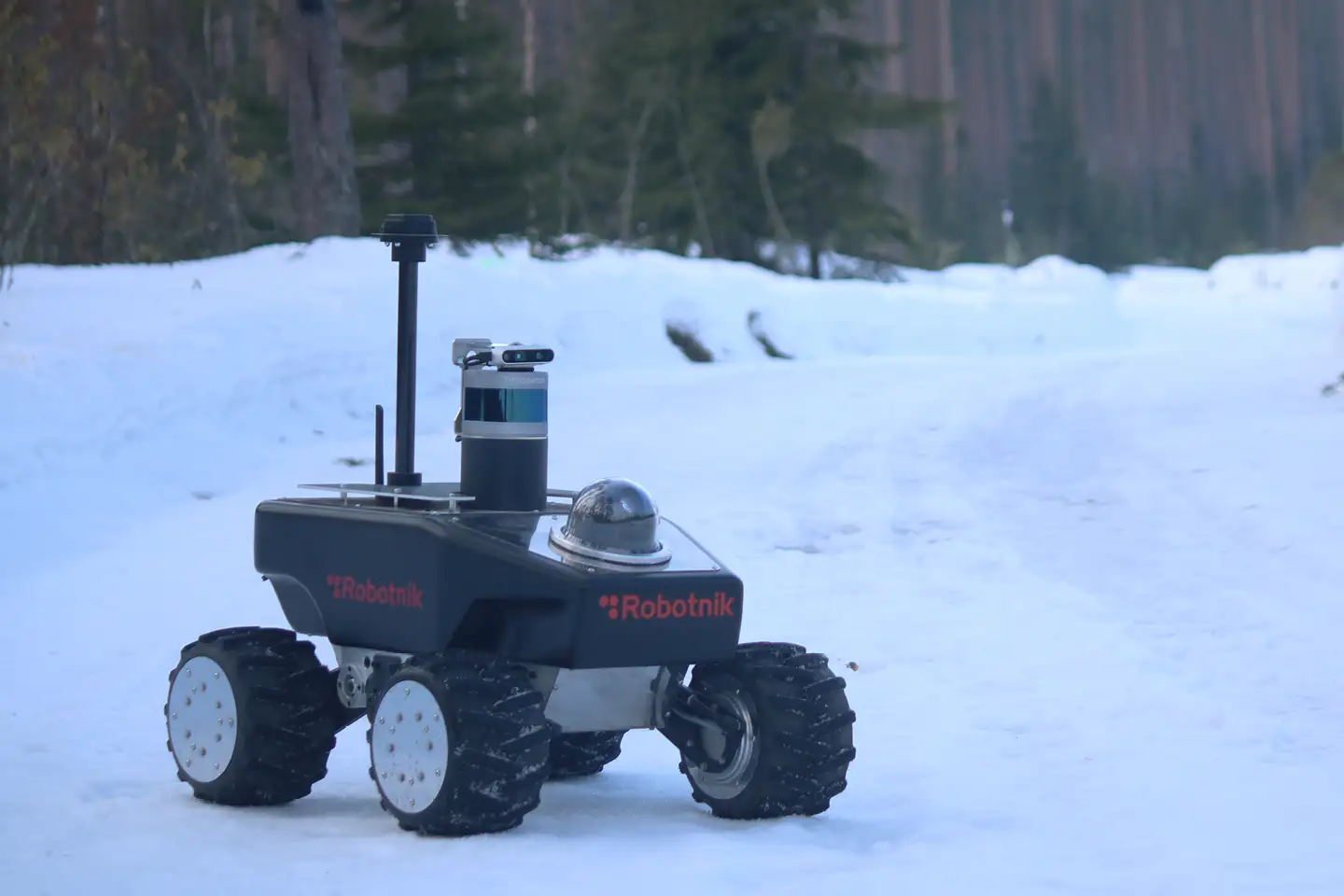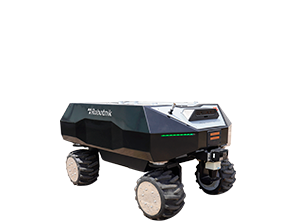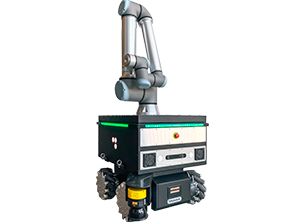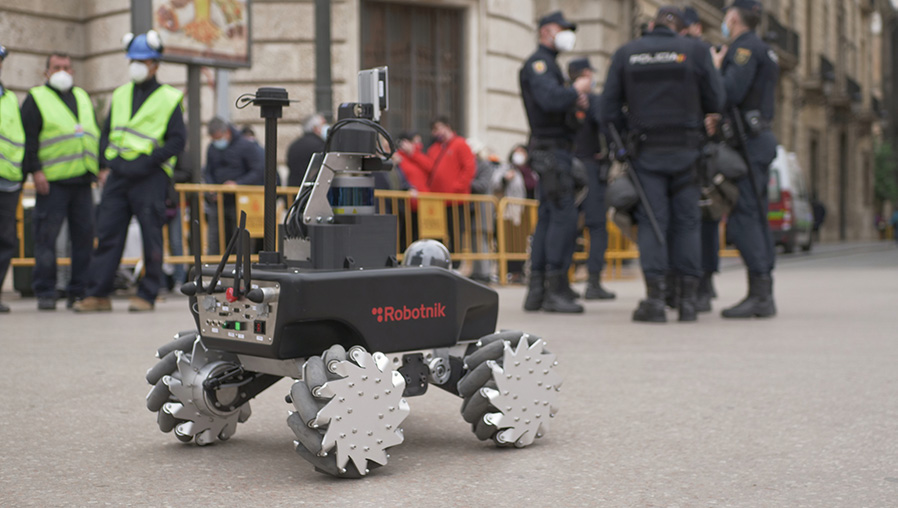Research and development (R&D) are the driving forces behind innovation in virtually every industrial and scientific sector. In this context, robotics for R&D has become a key tool for accelerating experimentation, testing, and validation of new technologies.
At Robotnik, we have been developing and providing mobile robotic platforms for over two decades, enabling research centers, universities, and business innovation departments to create, validate, and scale cutting-edge technological solutions.
In this article, we explore what robotics brings to the R&D sector, its specific applications, and why choosing modular platforms like those offered by Robotnik is a strategic decision for R&D projects.

GLOBAL INVESTMENT IN ROBOTICS R&D
In today’s global context, most countries have intensified their investments in robotics as part of their R&D strategies. According to the “World Robotics R&D Programs 2025” report from the International Federation of Robotics (IFR), countries like China, Japan, South Korea, the European Union, and the United States are adopting various approaches to foster innovation in this field.
For example, China has launched programs like the “Key Special Program on Intelligent Robots,” with a budget of about $45.2 million, aimed at promoting key technologies in strategic economic sectors. Japan, on the other hand, invested more than $930 million in robotics R&D in 2022, complemented by an additional $440 million in related projects within the Moonshot R&D Program. South Korea has established the “K-Humanoid Alliance,” a coalition bringing together companies, universities, and the government to develop advanced humanoid robots, aiming to lead this segment by 2030.
In Europe, robotics investment has been driven by initiatives like the NATO Innovation Fund, which supports tech startups in defense and robotics, addressing the need for dual-use technologies in the current geopolitical context, and Horizon Europe, the EU’s main funding program for research and innovation, where Robotnik has actively participated in over 20 projects. Meanwhile, in the United States, leading robotics companies have urged the government to establish a coordinated national strategy to effectively compete with technological advances from countries like China.
These trends reflect an international race to lead innovation in robotics, with increasing importance placed on collaboration between governments, industry, and academia.

WHAT IS ROBOTICS FOR R&D?
The goal of most robotics research projects is to bring them into the commercial realm and deliver real value to the industry. An example of this is the work Robotnik has carried out in recent years in R&D, focusing on robotics projects for inspection and safety. This effort culminated in the development and launch of RB-WATCHER, a closed and scalable commercial solution designed specifically for the industrial market.
Robotics for research and development refers to the use of robots and robotic platforms as experimental tools in scientific and technological projects, serving as a precursor to robust and proven commercialization. This phase allows researchers to:
- Test navigation algorithms, SLAM, computer vision, AI, etc.
- Simulate industrial or logistical environments.
- Validate sensors, manipulators, or autonomous systems.
- Integrate emerging technologies such as 5G, IoT, Edge Computing, or Digital Twins.
EXAMPLES OF ROBOTS FOR R&D
Any robot from Robotnik is suitable for R&D, as they are multipurpose, open, modular platforms with ROS-based architecture.
With more than 20 years of experience in R&D projects, Robotnik has developed cutting-edge robotic solutions tailored to the most demanding needs. Additionally, we have our own R&D department in robotics, formed by professionals and experts in integrating emerging technologies like augmented reality, the Internet of Things (IoT), Artificial Intelligence, Big Data, and 5G into our robots and mobile manipulators.
Here are some of the most used robots for R&D:
- RB-SUMMIT: A versatile, modular, and flexible AMR for indoor and outdoor use, ideal for tasks related to logistics, construction, or inspection.
- RB-VOGUI: A general-purpose robotic platform designed for outdoor R&D tasks, facilitating the development of end applications in sectors like agriculture or construction.
- RB-SUMMIT+: An Autonomous Mobile Manipulator designed to perform various R&D tasks in collaborative environments such as laboratories, research centers, and other academic settings, addressing end applications related to inspection, medicine, or logistics.
- RB-KAIROS+: An Autonomous Mobile Manipulator designed for plug-and-play integration with Universal Robots e-Series arms, especially useful for tasks such as Pick & Place, piece feeding, metrology, quality control, large part operations, packaging, cleaning, polishing, screwing, drilling, etc.
- Custom robots: These are other examples of custom robots we have developed specifically for R&D projects that required very specific customization, both in software and hardware.
BENEFITS OF ROBOTICS FOR R&D
As industrial environments become more complex, robotics must face new technological challenges to evolve at the pace that the industry demands. Research with robotics provides a flexible, repeatable, and scalable experimental foundation. Some key advantages of robotics for R&D include:
- Modularity and customization: Robotnik, as a manufacturer, has the ability to adapt its robotic platforms to certain levels to meet the specifications required by the project. In the R&D environment, standard configuration robots tend to be less suitable due to their limited ability to adapt to different testing scenarios and requirements.
- Controlled environment: Using robotics in R&D projects allows the creation of highly controlled testing environments where external variables remain constant. This ensures repeatability and guarantees that the results come only from changes introduced by the researcher. This accuracy contributes to the validity of the data obtained and reduces the possibility of industrial errors, improving reliability.
- Real-Time data: Robotnik's robots are equipped with advanced sensors that constantly collect information, such as temperature or pressure, throughout the project development. This enables continuous monitoring and informed decision-making. Real-time information facilitates the detection of errors and quick adjustments, improving efficiency and the quality of results.
- Accelerated development cycle: Robotics speeds up the test-and-error cycles by automating repetitive tasks, allowing for more iterations in less time. This is crucial in prototyping and validation. Robots can perform dozens of tests daily, reducing timelines and costs. Quick failure detection improves focus on solutions, driving more agile and competitive innovation.
SECTORS USING ROBOTICS FOR R&D
1. UNIVERSITIES AND RESEARCH CENTERS
Universities lead many robotics innovation projects, whether in autonomous mobility, navigation, AI, or security and inspection. Robots like RB-SUMMIT or RB-VOGUI are widely used in research projects such as Horizon Europe.
You can explore here examples of R&D projects in robotics involving Robotnik alongside various universities or technological centers.
2. INDUSTRY & LOGISTICS
Innovation departments in industrial companies also carry out R&D in robotics for developments such as:
- Testing autonomous transportation systems (AGVs/AMRs).
- Validating logistics optimization algorithms.
- Integrating new technologies like RFID or 3D vision in real-world environments.
3. PUBLIC BODIES
Public agencies and entities are increasingly investing in robotics R&D related to security and defense, for example, the development of autonomous surveillance, rescue, explosive detection, or recognition systems. Projects like NESTOR, HURRICANE, or CREST are some of the initiatives in which Robotnik has participated, implementing its robotic platforms.
ROBOTIC INNOVATION: THE FUTURE OF RESEARCH AND DEVELOPMENT
In conclusion, robotics has become a cornerstone of research and development processes, providing solutions that accelerate experiments, improve result accuracy, and open new frontiers in fields such as exploration and medicine. Its ability to automate complex tasks, along with high reliability and the capacity to integrate emerging technologies, not only drives scientific progress but also supports industrial competitiveness and the creation of innovative products. With robotics, researchers and companies can address complex problems with interdisciplinary approaches, developing technologies that have a transversal impact on various industries. Without a doubt, robotics is a key tool for the future of R&D, paving the way for faster, more precise, and accessible industrial implementation.
Preguntas frecuentes sobre la róbotica en la industria aeroespacial
Los robots móviles realizan tareas de alta precisión como inspecciones dimensionales, tratamientos de superficie y ensamblaje de componentes, garantizando calidad y seguridad.
Mejoran la repetibilidad, ahorran tiempo, no requieren de modificaciones en la planta y aumentan la seguridad gracias a la colaboración humano-robot.
Utilizan sistemas de escaneo 2D/3D para moverse de forma autónoma sin marcas en el suelo ni guías físicas.



